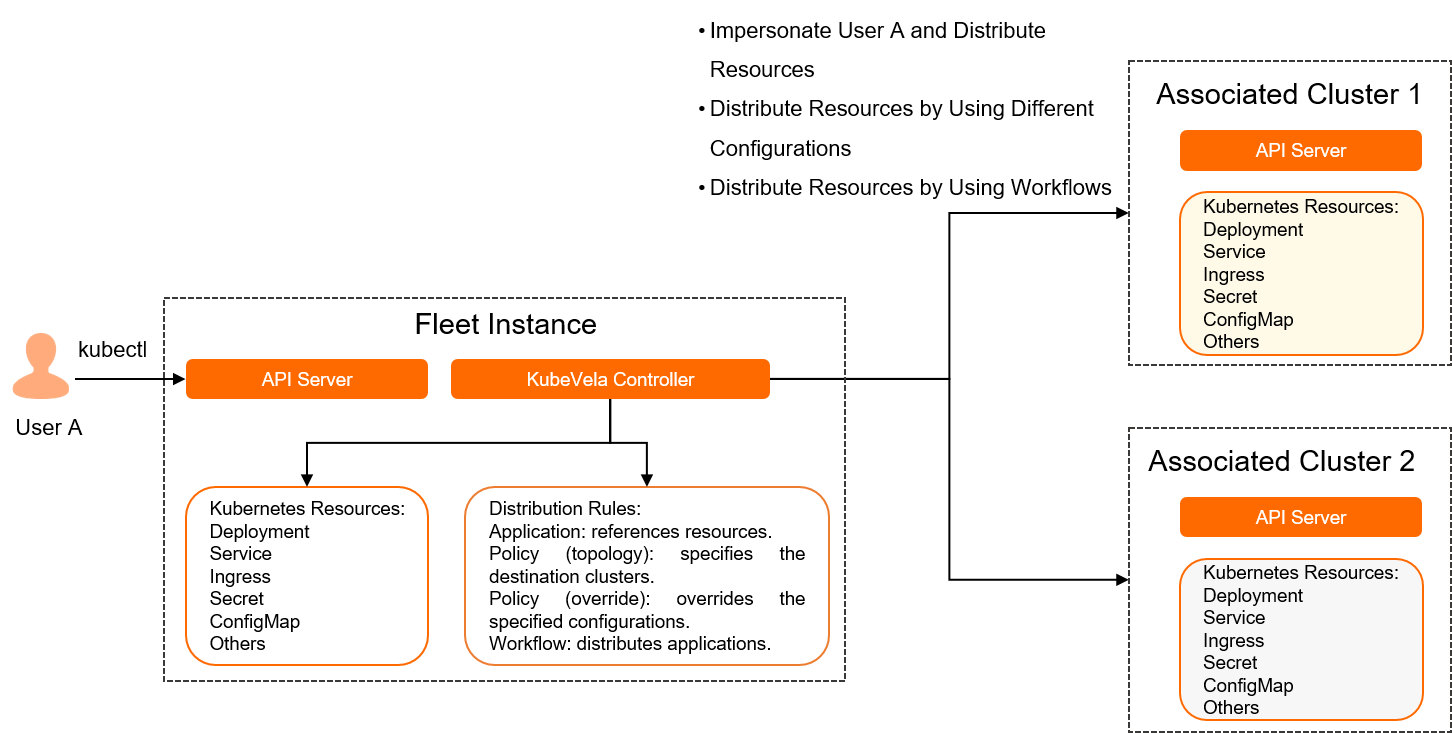You may face multiple challenges when you distribute an application across multiple clusters. For example, the kubeconfig files that are used to access the clusters are not unique, different configurations are used to deploy the application across clusters, no unified view is provided to check the deployment progress of the application, and risks may arise when you deploy the application across multiple clusters. To meet these challenges, you can use the multi-cluster management feature provided by Distributed Cloud Container Platform for Kubernetes (ACK One) to distribute an application across multiple clusters. This topic describes how to use the multi-cluster management feature provided by ACK One to distribute an application across multiple clusters.
Background information
The application distribution feature of ACK One is developed based on open source KubeVela. KubeVela is a modern software delivery control plane that you can use to simplify the procedure of distributing applications to multiple clusters. This feature provides standard Kubernetes APIs that can be used to distribute Kubernetes resources across multiple clusters. This feature allows you to use different configurations to deploy an application across clusters and perform canary releases for an application among clusters based on workflows. Fleet instances allow you to benefit from the application delivery capabilities of KubeVela and eliminate the need to manually create and maintain applications.
How application distribution works
Application distribution based on impersonation
For example, after User A creates or modifies an application on a Fleet instance, the Fleet instance distributes the resources that are used by the application to multiple associated clusters. During this process, the Fleet instance impersonates User A and sends resource creation requests or resource modification requests to the associated clusters. The creators or modifiers of these resources in the associated clusters are User A. This meets the requirements for separately auditing the associated clusters and improves cluster security. The following figure shows how an application is distributed based on impersonation.
Procedure
To use a Fleet instance in ACK One to distribute an application across multiple clusters, perform the following two steps.

Create the Kubernetes resources that are used by the application. You can configure distribution rules in Step 2. The following table describes the resources that can be distributed across clusters.
NoteThe distribution of the following resources does not trigger the creation of other relevant resources because Fleet instances do not monitor the creation of resources. For example, the distribution of Deployments does not trigger the creation of pods and the distribution of Services does not trigger the creation of endpoints.
Kind
apiVersion
Deployment
apps/v1
Service
v1
Ingress
networking.k8s.io/v1
ConfigMap
v1
Secret
v1
StatefulSet
apps/v1
PersistentVolumeClaim
v1
ServiceExport
multicluster.x-k8s.io/v1alpha1
ServiceImport
multicluster.x-k8s.io/v1alpha1
HorizontalPodAutoscaler
autoscaling/v1
Create rules on the Fleet instance to distribute the resources. You can create rules to reference the Kubernetes resources that are created in Step 1, select the clusters in which you want to deploy the application, use different configurations to deploy the application, and use the workflows feature to distribute the application.
Features
Feature | Description | References |
Deploy an application across multiple clusters | You can use a Fleet instance of ACK One to deploy an application across the clusters that are associated with the Fleet instance. To do this, you must create Kubernetes resources, such as Deployments, Services, and Ingresses, for the application. Then, you must specify the clusters in which you want to deploy the application. After you specify the clusters, create the application. You can view the deployment progress of the application in each cluster. | |
Use different configurations to deploy an application across multiple clusters | ACK One allows you to use a Fleet instance to deploy an application across multiple clusters. You can also use different configurations to deploy the application across the clusters. For example, you can specify different numbers of replicated pods, OS images, or environment variables for the application. | Use different configurations to deploy an application across multiple clusters |
Use canary releases to deploy an application across clusters | ACK One provides the workflows feature. This feature allows you to use canary releases to deploy an application. For example, you can first deploy an application in a testing cluster. If the application passes the test, you can deploy the application in production clusters. This helps minimize potential risks. | Use canary releases to deploy an application across clusters |
Select clusters to distribute an application | When you use a Fleet instance in ACK One to distribute an application, you must select the clusters to which you want to distribute the application. ACK One allows you to distribute an application to the clusters that are associated with a Fleet instance by specifying the cluster names or labels. | |
Rules for using different configurations to deploy an application across multiple clusters | ACK One allows you to use a Fleet instance to deploy an application across multiple clusters. You can also use different configurations to deploy the application across the clusters. | Rules for using different configurations to deploy an application across multiple clusters |
HPA | You can use the Horizontal Pod Ausoscaler (HPA) to control the number of replicated pods in associated clusters when you distribute applications in ACK One. |
Contact us
ACK One provides the following KubeVela features. To use more KubeVela features, join the DingTalk group 35688562 and contact the ACK One technical team.